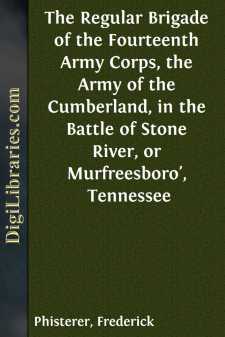Categories
- Antiques & Collectibles 13
- Architecture 36
- Art 48
- Bibles 22
- Biography & Autobiography 813
- Body, Mind & Spirit 142
- Business & Economics 28
- Children's Books 17
- Children's Fiction 14
- Computers 4
- Cooking 94
- Crafts & Hobbies 4
- Drama 346
- Education 46
- Family & Relationships 57
- Fiction 11829
- Games 19
- Gardening 17
- Health & Fitness 34
- History 1377
- House & Home 1
- Humor 147
- Juvenile Fiction 1873
- Juvenile Nonfiction 202
- Language Arts & Disciplines 88
- Law 16
- Literary Collections 686
- Literary Criticism 179
- Mathematics 13
- Medical 41
- Music 40
- Nature 179
- Non-Classifiable 1768
- Performing Arts 7
- Periodicals 1453
- Philosophy 64
- Photography 2
- Poetry 896
- Political Science 203
- Psychology 42
- Reference 154
- Religion 513
- Science 126
- Self-Help 84
- Social Science 81
- Sports & Recreation 34
- Study Aids 3
- Technology & Engineering 59
- Transportation 23
- Travel 463
- True Crime 29
The Regular Brigade of the Fourteenth Army Corps, the Army of the Cumberland, in the Battle of Stone River, or Murfreesboro', Tennessee
Description:
Excerpt
When General Rosecrans took command of the Army of the Ohio there were in that army five battalions of regular infantry in two different divisions; when he reorganized this army he determined to bring these battalions together, to give them a regular battery, and form of them a Regular Brigade. The 15th, 16th and 19th were already at Nashville; the orders organizing the brigade found the two battalions of the 18th near Gallatin, Tenn., as a part of General Stedman’s Brigade. On receipt of the orders, the 18th marched, on the 23d of December, 1862, from Pilot Knob to Nashville, Tenn., arriving there on the 25th day of December, 1862, and, joining the other battalions and the battery, it completed the formation of the brigade, which, as then organized, consisted of:
The 1st Battalion of the 15th Infantry: Companies A, B, C, D, E, F, G and H; commanded by Major John H. King.
The 1st Battalion of the 16th Infantry: Companies A, B, C, D, E, F, G and H, 1st Battalion, and Company B, 2d Battalion; Major A. J. Slemmer commanding.
The 1st Battalion of the 18th Infantry: Companies A, B, C, D, E, F, G and H, of the 1st, and A and D, of the 3d Battalion; Major J. N. Caldwell in command.
The 2d Battalion of the 18th Infantry: Companies A, B, C, D, E and F, of the 2d, and B, C, E and F, of the 3d Battalion; commanded by Major Frederick Townsend.
The 1st Battalion of the 19th Infantry: Companies A, B, C, D, E and F; Major S. D. Carpenter commanding.
Battery H, 5th U. S. Artillery, commanded by 1st Lieutenant F. L. Guenther.
Lieutenant-Colonel O. L. Shepherd, 18th U. S. Infantry, the senior officer, was placed in command of the brigade.
When the Army of the Ohio—then become the Army of the Cumberland, or the 14th Corps—advanced from Nashville, Tenn., toward its objective point, the enemy, the Regular Brigade broke camp on the 26th, encamping on the evening of that day on the Petersburg Turnpike; on the 27th it encamped near Nolansville, Tenn.; on the 28th, at night, it marched across the country to Stewart’s Creek, and on the 30th to a point on the Murfreesboro’ and Nashville Turnpike about four miles from Murfreesboro’, Tenn.
On the morning of the 31st of December the brigade left its bivouac at an early hour and advanced on the Nashville Turnpike to a point a little less than three miles northwest of Murfreesboro’, and, with its division, was posted in reserve. The division consisted of Scribner’s, John Beatty’s, Starkweather’s and the Regular Brigade, and was commanded by Major-General Lovell H. Rousseau. Starkweather’s Brigade had been left at Jefferson’s Crossing on Stone River. The division was part of the centre, commanded by Major-General George H. Thomas. The formation in the brigade was from right to left as follows: 15th, 16th, 18th, 1st and 2d Battalions, and the 19th.
To fully understand the events now following, it will be necessary to preface them with a short résumé of the opening and progress of the battle from 6.30 A. M. until noon; from the right of the army to the left of Palmer’s Division of the left wing.
The left of Palmer’s Division, Hazen’s Brigade, rested on the Nashville Turnpike, about two and a half miles northwest of Murfreesboro’, facing south by east—the other brigades of this division faced almost east; Negley’s Division, of the centre, next in order, faced south by east; Sheridan’s, of the right wing, faced almost east; Davis’ faced south by east, and Johnson’s, the right of the army, east and south, and a portion of it on the right flank west by south. A line drawn from the extreme right due north would have crossed the Nashville Turnpike near General Rosecrans’ headquarters, about one mile northwest of Hazen.
All the divisions, excepting Palmer’s and the left of Negley’s, had to cross a dense cedar forest about three-quarters of a mile deep before they could reach the Nashville Turnpike to their left and rear.
The extreme right of Johnson’s Division was attacked about 6.30 A....


